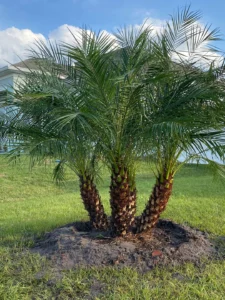Pygmy Date Palm
Palm Overview
Botanical Name: Phoenix Roebelenii
Bring instant elegance and tropical charm to your landscape or patio with the Pygmy Date Palm—a compact, eye-catching palm that’s big on beauty and low on maintenance. Known for its graceful, arching fronds and slender trunk, this dwarf palm adds a luxurious resort vibe without overwhelming your space.
Whether you’re enhancing a front yard, framing an entryway, or upgrading a poolside retreat, the Pygmy Date Palm is the perfect centerpiece or accent plant for tight spaces. It fits beautifully in containers, small gardens, courtyards, and patios.
Plant Characteristics
| Characteristic | Description |
|---|---|
| Height | 6 to 12 feet (1.8 to 3.7 meters) |
| Canopy Spread | 5 to 10 feet (1.5 to 3 meters) |
| Trunk | Slender, single or clumping; 3 to 6 inches (7.5 to 15 cm) in diameter, textured brown-gray |
| Fronds | Arching, feathery pinnate leaves, 3 to 4 feet (0.9 to 1.2 meters) long |
| Growth Rate | Slow to moderate |
Environmental Needs
| Environmental Factor | Description |
|---|---|
| Sunlight | Prefers bright, indirect light to partial shade; can tolerate full sun in mild climates |
| Soil | Well-draining, sandy or loamy soil; prefers slightly acidic to neutral pH (6.0–7.0) |
| Watering | Keep soil moderately moist; water regularly during growing season but avoid waterlogging; drought-tolerant once established |
| Hardiness | USDA Zones 10–11; tolerates temperatures down to about 25°F (-4°C); sensitive to frost |
Fruit and Flowering
Certainly! Here’s a Fruit and Flowering Table for the Pygmy Date Palm (Phoenix roebelenii) with the details you asked for:
| Category | Description |
|---|---|
| Fruit | Small, oval-shaped drupe, red to black when ripe, about 0.5 inches long; edible but not commonly consumed |
| Sex | Dioecious (separate male and female plants) |
| Time of Fruit | Fruits develop in late summer to early fall, typically after 3–4 years of growth on mature female plants |
Uses
Ornamental Accent: Perfect as a stylish focal point or accent plant in gardens, patios, and landscapes.
Container Plant: Thrives in pots and containers—great for patios, balconies, and indoor spaces.
Tropical Landscaping: Adds lush, tropical appeal to poolside areas, courtyards, and resort-style settings.
Indoor Decoration: Popular as an indoor palm due to its manageable size and graceful fronds.
Screening & Privacy: Can be planted in groups or clusters to create natural privacy screens or windbreaks.
Pathway/Walkway Borders: Used to line walkways or driveways for an elegant, tropical look.
Shade Understory: Suitable for planting under taller trees where it receives filtered sunlight.
Low-Maintenance Garden: Ideal for gardeners seeking a beautiful yet easy-to-care-for palm.
Wildlife Attraction: Produces fruits that attract birds and small wildlife.
Commercial Use: Frequently used in commercial landscapes such as hotels, resorts, and office parks for a polished tropical ambiance.
Maintenance
Watering: Keep soil consistently moist but not soggy; water deeply about 2–3 times per week during warm months; reduce watering in winter.
Fertilizing: Feed with a balanced slow-release palm fertilizer 2–3 times per year (spring, summer, fall) to promote healthy growth.
Pruning: Remove dead or yellowing fronds regularly; use gloves and eye protection as the petioles can have sharp spines.
Soil Care: Ensure good drainage to prevent root rot; avoid waterlogging.
Light Adjustment: If grown indoors, rotate the plant periodically to ensure even light exposure.
Cold Protection: Protect from frost or freezing temperatures; move container plants indoors during cold snaps.
Repotting: Repot every 2–3 years or when root-bound, using well-draining potting mix suitable for palms.
Cleaning: Occasionally wipe fronds with a damp cloth to remove dust and keep leaves vibrant.
Monitoring: Regularly inspect for signs of nutrient deficiencies (yellowing fronds) or disease.
